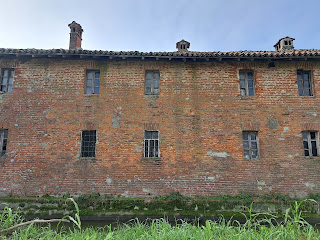Maria, stella mattutina, all'inizio del giorno di cammino rivolgiamo il nostro pensiero a te. Ti affidiamo i passi di questo pellegrinaggio fino a sera, chiediamo il sostegno nella fatica del corpo e dell'anima. Ti chiediamo la gioia del cuore, la speranza dell'alba, la fortezza del mezzogiorno, la pace della sera.
- pilgrims' prayer, posted in the chapel in Nicorvo
My Dutch roommates and I were in bed by nine, so I was up early and on the trail by a quarter past seven. The sun rises later these days, and I was already walking through Robbio's "industrial zone" and past the football stadium as the birds sang their dawn chorus.
As a matter of fact the birds were the highlight of today's walk. Grey herons, great white egrets, and a bird I hadn't seen before: the African sacred ibis.
The African sacred ibis (Threskiornis aethiopicus) is a wading bird native to much of Africa, as well as small parts of Iraq, Iran and Kuwait, famous for its role in the religion of Ancient Egypt. It was connected with the Ibis-headed god Thoth, associated with the arbitration of godly disputes, the arts of magic and writing, and the judgment of the dead. For many centuries in pre-Roman Egypt, tens of thousands of birds were buried in temples every year, and ibis breeding farms (called ibiotropheia by Herodotus) may have been set up to sustain sufficient numbers for the demand for sacrifices by pilgrims from all over Egypt. Whether for this reason or due to hunting in later centuries, by 1850 the species had disappeared from Egypt, but it is now increasingly common in Europe.
 |
| Thoth |
 |
| Sacred African Ibis wing feather |
 |
| Sacred African ibis (not my picture - from Wikipedia) |
The ibises never hung around long enough for me to get a good picture, so here's one from Wikipedia!
Judging from the shells littering the path, I seemed to have interrupted them in the middle of a crayfish feast.
After an hour or so among the rice paddies I crossed the river Agogna and walked along the roadside into the village of Nicorvo, where I stopped for a coffee and croissant. The café owner told me I could get a stamp for my credential at the little church right where the Via Francigena turns a corner, known as the Madonnina, so I stopped in there before leaving the village behind for more rice paddies, ibises and crayfish claws.
 |
| Torrente Agogna |
A few minutes' walk outside Nicorvo, I spoke to a man with a scythe who was cutting sheaves of rice in the corners of a small rice paddy and throwing them into the middle. I asked why, and he told me the rice was going to be harvested today - if it doesn't rain - and the harvester can't manœuvre around the corners of the field. He wanted to make sure every stalk of rice got harvested! He told me the rice would be sold to one of the big processing plants. In Robbio I had walked past the head offices of Riso Gallo, one of the biggest Italian brands, and seen the processing plant in the distance. The industrial rice processing plants have taken over from the family-owned cascine like the one I walked past a few minutes further down the trail, where everything was done by hand, or using simple machinery powered by either water or donkeys!
 |
| Church of Santa Croce |
 |
| Church of Santa Croce |
 |
| Mortara cathedral (built 1375-1380) |
 |
| Bricks from the four holy gates of Rome |
 |
| San Rocco, patron saint of pilgrims (and the sick) |





















No comments:
Post a Comment